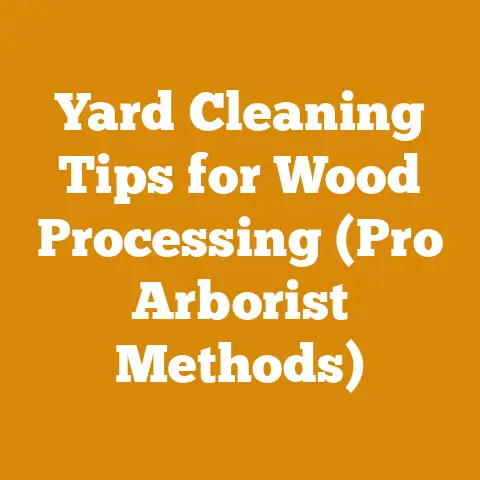Can You Burn Birch in a Wood Stove? (5 Pro Tips for Clean Heat)
Can You Burn Birch in a Wood Stove? (5 Pro Tips for Clean Heat)
Want to transform birch logs into cozy winter warmth without smoking out your neighbors or damaging your wood stove?
I’ve spent years wrestling with chainsaws, splitting mauls, and the sometimes-frustrating realities of firewood preparation.
Birch, with its beautiful bark and decent heat output, is a common sight in many woodpiles.
However, it’s not always the easiest wood to burn cleanly and efficiently.
Through trial and error, and plenty of research, I’ve learned some crucial tips for getting the most out of birch in a wood stove.
This isn’t just about throwing logs in the fire; it’s about understanding the wood, preparing it properly, and burning it in a way that maximizes heat and minimizes creosote buildup.
Understanding Birch as Firewood
Birch is a hardwood, but it’s on the softer side compared to oak or maple.
This means it’s easier to split, but it also burns faster.
Different birch species exist, including white birch (paper birch), yellow birch, and gray birch.
White birch is common and relatively easy to identify by its distinctive peeling bark.
- Heat Output: Birch typically produces around 20 million BTUs per cord, which is a decent amount of heat.
It’s not as high as some of the denser hardwoods, but it’s a solid choice, especially if it’s readily available in your area. - Creosote Concerns: Birch bark contains oils that can contribute to creosote buildup in your chimney if not burned properly.
This is a key reason why proper drying and burning techniques are essential. - Availability and Cost: The cost of birch firewood varies widely depending on your location and the supplier.
In some areas, birch might be abundant and relatively inexpensive, while in others, it might be more expensive due to limited supply or higher demand.
Pro Tip #1: Seasoning is Key (and Here’s How to Do It Right)
The most crucial step in burning birch cleanly is proper seasoning.
Green birch can have a moisture content of over 50%, which makes it difficult to light, causes it to smoke excessively, and significantly increases creosote buildup.
Seasoning reduces the moisture content to 20% or less, making it burn cleaner and more efficiently.
- The Six-Month Rule (Minimum): While some hardwoods require a year or more to season properly, birch can often be seasoned adequately in about six months, if conditions are ideal.
However, don’t rush it.
Check the moisture content with a moisture meter. - Splitting Early: Split the birch as soon as possible after felling.
Smaller pieces dry faster than large rounds.
Splitting also exposes more surface area to the air, accelerating the drying process. - Stacking Smart: Stack the split wood in a single row, raised off the ground on pallets or scrap wood.
This allows air to circulate freely around the woodpile.
Leave space between rows for even better airflow. - Sun and Wind: Choose a sunny and windy location for your woodpile.
Sunlight helps to evaporate moisture, and wind carries it away.
If possible, orient the woodpile so that it faces the prevailing wind. - Moisture Meter is Your Friend: Don’t rely on guesswork.
Invest in a moisture meter.
You want the moisture content to be below 20% before burning.
Test several pieces of wood in different spots to get an accurate reading.
You can find decent moisture meters for around $20-$50. - Personal Experience: I once tried to burn birch that I thought was seasoned, but it turned out to be too wet.
The fire was sluggish, it produced a lot of smoke, and I ended up with a significant amount of creosote in my chimney.
Lesson learned: always check the moisture content!
Cost Considerations for Seasoning:
While seasoning itself doesn’t cost much in terms of materials, it does require time and space.
- Land Use: The cost of land, if applicable, is a factor.
If you’re renting or leasing land for firewood processing, the cost needs to be factored into your budget. - Pallets: Pallets for raising the wood off the ground can often be obtained for free from local businesses.
- Tarps (Optional): If you live in a very wet climate, you might want to cover the woodpile with a tarp to protect it from rain.
A good quality tarp can cost anywhere from $30 to $100, depending on the size and material. - Labor: Your time is valuable.
Factor in the time it takes to split, stack, and monitor the woodpile.
If you’re paying someone to do this, the labor costs will be significant.
Example Cost Breakdown (Seasoning 5 Cords of Birch):
- Land Use (if applicable): $50 – $200 (depending on rental costs)
- Pallets: $0 (assuming free from local businesses)
- Tarp (Optional): $50
- Labor (Your Time – estimated at $20/hour for 10 hours): $200
- Moisture Meter: $30 (one-time purchase)
Total Estimated Cost: $330 – $480 (excluding the moisture meter, which is a reusable tool).
Cost Optimization:
- Obtain pallets for free from local businesses to avoid purchasing new ones.
- Carefully consider whether a tarp is necessary based on your local climate.
- Maximize your efficiency when splitting and stacking to reduce labor time.
Pro Tip #2: Top-Down Burning for Cleaner Combustion
Traditional wood stove operation often involves lighting the fire from the bottom.
While this can work, it’s not the most efficient or cleanest way to burn wood, especially birch.
Top-down burning, also known as the “upside-down fire,” is a technique that promotes cleaner combustion and reduces smoke.
- How It Works: Instead of placing kindling at the bottom and logs on top, you do the opposite.
Place the largest logs at the bottom, then layer smaller pieces on top, finishing with kindling and tinder at the very top. - Why It’s Better: When you light the fire from the top, the gases released from the wood have to pass through the hot coals below, which helps to burn them more completely.
This results in less smoke, more heat, and less creosote buildup. - Starting the Fire: Use a natural fire starter or small pieces of kindling to ignite the top layer.
Be patient; it might take a few minutes for the fire to establish itself. - Air Control: Once the fire is burning well, gradually reduce the air intake to the stove.
This will slow down the burn rate and allow the fire to burn more efficiently. - Personal Experience: I was skeptical of top-down burning at first, but after trying it, I was amazed at the difference.
The fire burned longer, produced less smoke, and the stove stayed cleaner.
Cost Considerations for Top-Down Burning:
Top-down burning doesn’t require any additional materials or equipment, so there are no direct costs associated with it.
However, it does require a bit more attention and effort when starting the fire.
- Time Investment: It might take a few tries to master the technique.
Be patient and experiment with different arrangements of wood until you find what works best for your stove. - Fire Starters: You might use more fire starters initially as you get used to the technique.
Natural fire starters can be made from pinecones and wax, which can be a cost-effective option.
Example Cost Breakdown (Fire Starters):
- Pinecones: Free (if you have access to pine trees)
- Wax (Recycled Candles): Free (using leftover candle wax)
- Sawdust: Free (from woodworking projects)
- Paper Egg Cartons: Free (recycled)
Total Estimated Cost: Minimal, as you’re using recycled materials.
Cost Optimization:
- Use natural and recycled materials for fire starters to minimize costs.
- Practice the top-down burning technique to become more efficient at starting fires.
Pro Tip #3: Air Control is Your Best Friend (and Your Chimney’s Too)
Proper air control is crucial for clean and efficient burning, regardless of the type of wood you’re using.
It’s especially important with birch, due to its potential for creosote buildup.
- Understanding Airflow: Wood stoves have primary and secondary air controls.
Primary air controls the amount of air entering the stove from below, which affects the burn rate.
Secondary air introduces air higher up in the firebox, which helps to burn the gases released from the wood. - Finding the Sweet Spot: The key is to find the “sweet spot” where the fire is burning hot enough to burn the gases completely, but not so hot that it’s wasting fuel.
- Signs of Poor Air Control: If you see a lot of smoke coming from your chimney, it’s a sign that you’re not getting complete combustion.
This could be due to too little air, too much air, or wet wood. - Experimentation is Key: Every stove is different, so you’ll need to experiment with the air controls to find what works best for your setup.
Start with the air controls fully open when starting the fire, and then gradually reduce them as the fire gets established. - Observe the Flames: The flames should be bright and lively, not dark and smoky.
If the flames are lazy and orange, it’s a sign that you need more air. - Personal Experience: I used to struggle with getting my wood stove to burn cleanly.
I would either have a roaring fire that burned through wood quickly, or a smoldering fire that produced a lot of smoke.
After learning about proper air control, I was able to fine-tune the settings and get a much cleaner and more efficient burn.
Cost Considerations for Air Control:
Proper air control doesn’t involve any direct costs, but it can save you money in the long run by reducing wood consumption and minimizing chimney cleaning expenses.
- Reduced Wood Consumption: Efficient burning means you’ll use less wood to heat your home.
This can translate into significant savings over the course of a winter. - Reduced Chimney Cleaning Costs: Less creosote buildup means you won’t have to clean your chimney as often.
Professional chimney cleaning can cost anywhere from $150 to $300 per cleaning. - Potential Safety Benefits: Reduced creosote buildup also lowers the risk of chimney fires, which can be devastating and expensive.
Example Cost Savings (Air Control vs. Inefficient Burning):
Let’s assume you typically burn 5 cords of wood per winter at $250 per cord ($1250 total).
With proper air control, you might reduce your wood consumption by 20%, saving you one cord of wood.
- Savings on Wood: 1 cord x $250/cord = $250
- Savings on Chimney Cleaning: Reduced cleaning frequency (e.g., cleaning every other year instead of annually) = $150 savings per year.
Total Estimated Savings: $400 per year.
Cost Optimization:
- Learn how to properly adjust the air controls on your wood stove.
- Monitor your wood consumption and chimney buildup to assess the effectiveness of your burning practices.
Pro Tip #4: Burn Hot and Fast (Within Reason)
While it might seem counterintuitive, burning birch hot and fast, within the stove’s safe operating range, is often better than smoldering it slowly.
This is because hotter fires burn the gases released from the wood more completely, reducing smoke and creosote.
- Avoid Smoldering Fires: Smoldering fires are inefficient and produce a lot of smoke and creosote.
They also don’t generate much heat. - Establish a Hot Fire Quickly: When starting a fire, aim to get it burning hot as quickly as possible.
This will help to establish a good draft in the chimney and prevent smoke from backing up into the house. - Monitor Stove Temperature: Use a stove thermometer to monitor the temperature of your wood stove.
Most stoves have a recommended operating temperature range.
Stay within that range to avoid overheating the stove or damaging the chimney. - Don’t Overload the Stove: Overloading the stove with wood can restrict airflow and lead to a smoldering fire.
Load the stove with a reasonable amount of wood, leaving space for air to circulate. - Personal Experience: I used to think that I was saving wood by burning it slowly, but I quickly realized that it was a false economy.
The fire was inefficient, the stove was dirty, and I was constantly having to clean the chimney.
Once I started burning the wood hotter and faster, I saw a significant improvement in efficiency and cleanliness.
Cost Considerations for Burning Hot and Fast:
Burning hot and fast might seem like it would increase wood consumption, but in reality, it can actually save you money by improving efficiency and reducing maintenance costs.
- Improved Efficiency: A hot fire burns wood more completely, extracting more heat from each log.
This means you’ll need less wood to heat your home. - Reduced Maintenance Costs: Less creosote buildup means you won’t have to clean your chimney as often, saving you money on professional cleaning services.
- Potential Safety Benefits: A hot fire helps to keep the chimney clear of creosote, reducing the risk of chimney fires.
Example Cost Savings (Hot and Fast vs. Smoldering):
Let’s assume you typically spend $300 on chimney cleaning each year.
By burning hot and fast, you might reduce the frequency of cleaning to every other year.
- Savings on Chimney Cleaning: $300 / 2 years = $150 per year.
- Potential Savings on Wood: While hard to quantify, improved efficiency can lead to a noticeable reduction in wood consumption.
Total Estimated Savings: $150+ per year.
Cost Optimization:
- Learn how to properly operate your wood stove to achieve a hot and efficient burn.
- Monitor your wood consumption and chimney buildup to assess the effectiveness of your burning practices.
Pro Tip #5: Regular Chimney Inspections and Cleaning are Non-Negotiable
Regardless of how carefully you burn birch, some creosote buildup is inevitable.
Regular chimney inspections and cleaning are essential for preventing chimney fires and ensuring the safe operation of your wood stove.
- Annual Inspections: Have your chimney inspected by a qualified professional at least once a year, even if you don’t use your wood stove frequently.
- Cleaning Frequency: The frequency of cleaning will depend on how often you use your wood stove and how cleanly you burn.
If you burn birch regularly, you might need to clean your chimney more often than if you burn drier, denser hardwoods. - DIY Cleaning (with Caution): You can clean your chimney yourself, but it’s important to use the right tools and techniques.
Purchase a chimney cleaning brush that is the correct size and shape for your chimney.
Always wear a dust mask and eye protection. - When to Call a Professional: If you’re not comfortable cleaning your chimney yourself, or if you suspect that there’s a significant amount of creosote buildup, call a professional chimney sweep.
- Personal Experience: I once neglected to clean my chimney for several years, thinking that I was burning cleanly enough.
One day, I noticed a strong burning smell coming from the chimney.
I immediately called a professional, who found a significant amount of creosote buildup.
I was lucky to have caught it before a chimney fire started.
Cost Considerations for Chimney Inspections and Cleaning:
Chimney inspections and cleaning are an essential expense for anyone who uses a wood stove.
- Professional Inspection: $100 – $200 per inspection
- Professional Cleaning: $150 – $300 per cleaning
- DIY Cleaning Supplies: $50 – $100 (one-time purchase for brush and other tools)
Example Cost Breakdown (Chimney Maintenance):
- Annual Inspection: $150
- Cleaning (Every Other Year): $200 / 2 years = $100 per year
Total Estimated Cost: $250 per year.
Cost Optimization:
- Learn how to clean your chimney yourself to save money on professional cleaning services.
- Regularly inspect your chimney for signs of creosote buildup.
- Burn wood cleanly to minimize creosote buildup and reduce the frequency of cleaning.
Additional Cost Considerations for Firewood Preparation
Beyond the specific tips for burning birch, there are broader cost factors to consider when preparing firewood.
1. Wood Source and Procurement:
- Free Wood: If you have access to free wood (e.g., from your property or from a friend), your costs will be significantly lower.
However, you’ll still need to factor in the cost of your time and equipment. - Purchased Wood: The cost of purchased wood varies widely depending on the species, quality, and location.
A cord of birch can range from $150 to $400 or more, depending on your area. - Permits and Fees: In some areas, you might need a permit to cut wood on public land.
These permits can cost anywhere from $20 to $100 or more, depending on the location and the amount of wood you’re allowed to take.
2. Tools and Equipment:
- Chainsaw: A good quality chainsaw is essential for felling trees and cutting logs to length.
Chainsaws can range in price from $200 to $1000 or more, depending on the size and features. - Splitting Maul or Wood Splitter: A splitting maul is a traditional tool for splitting wood by hand.
Wood splitters are powered machines that can split wood much faster and with less effort.
Wood splitters can range in price from $500 to $3000 or more. - Safety Gear: Safety gear is essential for protecting yourself from injury.
This includes a helmet, eye protection, ear protection, gloves, and chainsaw chaps.
Safety gear can cost anywhere from $100 to $300 or more. - Wedges and Sledgehammer: Wedges and a sledgehammer can be helpful for splitting particularly tough logs.
Wedges can cost anywhere from $20 to $50 each. - Axe: An axe is useful for limbing trees and splitting small pieces of wood.
Axes can range in price from $50 to $200 or more.
3. Labor Costs:
- Your Time: Your time is valuable.
Factor in the time it takes to fell trees, cut logs, split wood, stack wood, and transport wood.
If you’re paying someone to do this, the labor costs will be significant. - Hiring Help: If you’re not able to do all of the work yourself, you might need to hire help.
Labor costs can vary widely depending on the location and the skill level of the workers.
4. Transportation Costs:
- Truck or Trailer: You’ll need a truck or trailer to transport the wood from the source to your home.
If you don’t own a truck or trailer, you might need to rent one. - Fuel Costs: Factor in the cost of fuel for your truck or trailer.
5. Maintenance and Repairs:
- Chainsaw Maintenance: Chainsaws require regular maintenance, including sharpening the chain, cleaning the air filter, and changing the oil.
- Wood Splitter Maintenance: Wood splitters also require regular maintenance, including changing the oil and lubricating the moving parts.
- Repairs: Unexpected repairs can be costly.
Set aside a budget for potential repairs to your tools and equipment.
Example Cost Breakdown (Preparing 5 Cords of Firewood):
This is a rough estimate, and your actual costs may vary depending on your specific circumstances.
- Wood Source (Purchased Birch): $250/cord x 5 cords = $1250
- Chainsaw (One-Time Purchase): $500
- Wood Splitter (One-Time Purchase): $1500
- Safety Gear (One-Time Purchase): $200
- Fuel and Oil: $100
- Maintenance and Repairs: $100
- Labor (Your Time – estimated at $20/hour for 40 hours): $800
Total Estimated Cost: $4450 (excluding the one-time purchases of the chainsaw, wood splitter, and safety gear).
Cost Optimization:
- Obtain free wood whenever possible.
- Purchase used tools and equipment to save money.
- Maintain your tools and equipment properly to extend their lifespan.
- Do as much of the work yourself as possible to reduce labor costs.
- Transport wood efficiently to minimize fuel costs.
Calculating Firewood Volume: Cords, Face Cords, and Board Feet
Understanding how firewood is measured is essential for budgeting and making informed purchasing decisions.
- Cord: A cord is a standard unit of measurement for firewood, defined as a stack of wood that is 4 feet high, 4 feet wide, and 8 feet long, totaling 128 cubic feet.
- Face Cord (or Rick): A face cord is a stack of wood that is 4 feet high and 8 feet long, but the width can vary.
The price of a face cord should be adjusted based on its actual width compared to a full cord. - Board Foot: Board feet are typically used for measuring lumber, not firewood.
However, if you’re harvesting your own timber, you might need to calculate the volume of logs in board feet.
The formula for calculating board feet is: (Thickness in inches x Width in inches x Length in feet) / 12.
Calculating the Volume of a Face Cord:
To determine the equivalent of a face cord in terms of a full cord, you need to know the width of the face cord.
For example, if a face cord is 16 inches wide, it is one-third of a full cord (16 inches / 48 inches = 1/3).
Example Calculation:
- Price of a full cord: $300
- Width of face cord: 16 inches
- Equivalent value of face cord: $300 / 3 = $100
Cost Optimization:
- Always clarify the dimensions of a “face cord” before purchasing.
- Calculate the equivalent value of a face cord compared to a full cord to ensure you’re getting a fair price.
Actionable Takeaways
Burning birch in a wood stove can be a rewarding way to heat your home, but it requires attention to detail and a commitment to best practices.
- Season your birch properly: Aim for a moisture content of 20% or less.
- Use top-down burning: This technique promotes cleaner combustion and reduces smoke.
- Control the airflow: Find the sweet spot where the fire is burning hot and efficiently.
- Burn hot and fast: Avoid smoldering fires, which produce a lot of smoke and creosote.
- Inspect and clean your chimney regularly: This is essential for preventing chimney fires.
By following these tips, you can enjoy the warmth and beauty of a birch fire while minimizing the risks of creosote buildup and chimney fires.
Remember, safety and efficiency are always the top priorities.
Next Steps for Planning Your Firewood Project
- Assess your needs: Determine how much firewood you’ll need for the winter.
- Evaluate your resources: Do you have access to free wood, or will you need to purchase it?
- Create a budget: Factor in the cost of wood, tools, equipment, and maintenance.
- Develop a plan: Outline the steps you’ll need to take to prepare your firewood, from felling trees to stacking wood.
- Gather your supplies: Purchase the necessary tools and equipment.
- Get to work: Start preparing your firewood well in advance of winter.
- Stay safe: Always wear safety gear and follow safe operating procedures.
By taking these steps, you can ensure that you have a safe and efficient firewood supply for the winter.
Happy burning!






